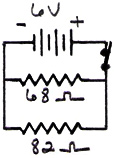A parallel circuit is formed when the circuit elements are connected on separate conducting paths. If you begin to trace a path from the positive terminal of the voltage source and you reach a point where there is more than one path you could follow to return to the negative terminal of the voltage source, the circuit is a parallel circuit.
An advantage of a parallel circuit is that if one path of the parallel circuit is open, current can still flow through the other conducting paths in the circuit.
![]() The following video gives a more in-depth analysis of parallel circuits:
The following video gives a more in-depth analysis of parallel circuits:
Source: Circuits (part3), Khan Academy, YouTube
Visit Parallel Circuits, view the animation and write the rules for voltage V, current I, and resistance R in your notes.
A circuit contains a 6 V battery and a 62 Ω resistor and an 82 Ω resistor arranged in parallel.


